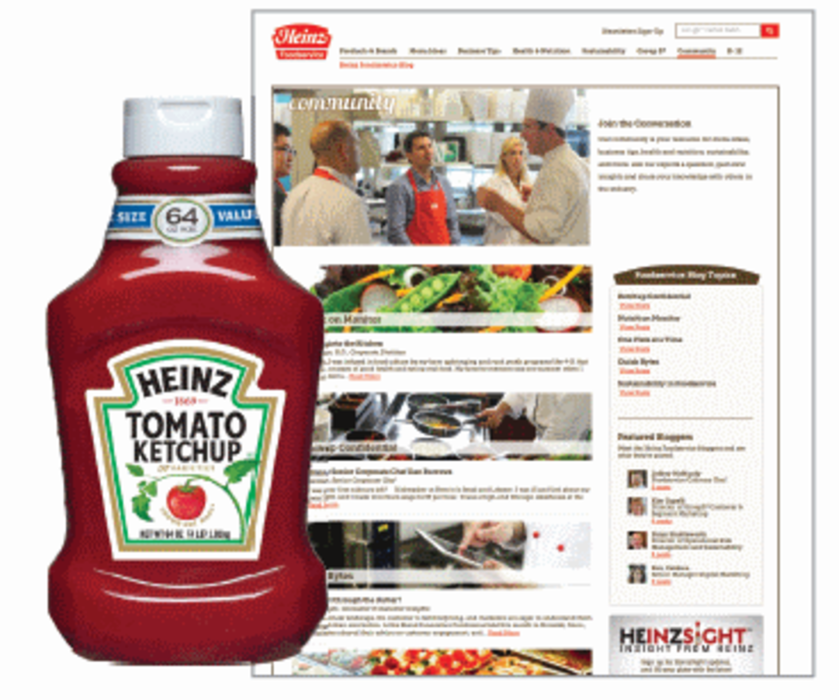Client: H.J. Heinz Company
Agency: Communispace
Objective: Develop a thriving online community where foodservice professionals can connect with Heinz and their peers
The Back Story: Every brand should do some internal myth-busting once in a while—because what you always thought was trueabout your customers may be more nuanced than you previously believed. Gaining a deeper understanding of customers can lead to greater insights, smarter product offerings, and richer relationships.
That’s exactly what happened when H.J. Heinz Company began to delve into the minds, hearts, and stomachs of its B2B customer base. The global foodstuffs brand tapped into a group of 300 decision-making foodservice professionals that included restaurant managers, chefs, line cooks, and even a guy who runs the cafeteria on an oil rig, via an online community dubbed “Let’s Dish.”
“You don’t own your brand more than the consumers do,” says Jen Reddy, SVP of global marketing at Communispace, the market research agency that helped Heinz create and monitor the Let’s Dish community. “That’s why we invited them to a seat at the virtual table and asked for their help.”
The Data: Heinz and Communispace originally launched the Let’s Dish community as a research tool to get feedback from invited guests on its existing initiatives. It soon became apparent from listening to chatter that what foodservice professionals were missing was a Web-based hub where they could discuss the industry and get specific information to meet their business needs.
Heinz also learned that most foodservice professionals typically only visited manufacturers’ sites roughly once a year for product information or spec sheets. They actually picked up most of their inspiration from consumer websites like allrecipes.com or food.com, because there “wasn’t anywhere [foodservice professionals] could go to find content customized and tailored to their needs,” says Amy Kleppinger, associate research manager of consumer and customer insights at Heinz.
Kleppinger and her team also realized how keen foodservice operators were to pool intellectual resources with each other, an insight that busted to bits the misconception that foodservice professionals viewed each other solely as competitors. Heinz also noticed that their interests went beyond menu choices and food to include everything from HR to IT issues.
“They’re actually really collaborative and they see themselves as a community of foodservice professionals,” Kleppinger says. “That gave us permission to build that sense of community into our online strategy.”
The Strategy: Heinz used what it learned from Let’s Dish to relaunch heinzfoodservice.com, a site that serves as the digital nexus between the brand and its B2B customers. It has regularly updated content, including menu ideas, business tips, blogs, information on health, nutrition, and sustainability, and articles on everything from the “sweet potato fry revolution” to the great condiment debate: whether to buy squeeze dispensers or individual packets.
The beauty of Heinz’s content strategy is the way in which it embraces information designed to be useful to the brand’s audience, whether or not that content is Heinz-focused, much in the same vein as the Huggies Mommy Answers site or the Clorox myStain app.
“Part of the evolution into the digital space is that people don’t want to be talked at anymore. They want a conversation,” says Josie Cellone, digital marketing manager at Heinz. “What you post can’t be just self-serving headlines that are constantly pushing the brand and talking about the products.”
For example, an article on heinzfoodservice.com about the launch of a new barbecue sauce line would focus on why the product is being launched (because people like to customize their food) rather than simply sit under a dry, press release–style headline like, “Heinz Launches Six New Barbecue Sauces.”
Heinz views itself as a conversation curator, not a conversation controller, says Cellone: “We don’t want to be sending out one-way messaging; we listen to what the restaurants are talking about. It’s about response time, relevance, and inserting yourself into the conversations your customers are already having.”
All the content on the site is original, sourced both in-house and externally from Heinz’s various research partners and from a content agency. “We’re trying to run the website a bit like a newsroom,” Kleppinger says.
The Results: Heinz also sends dedicated “HeinzSight” newsletters to an organic list. The recipients have all opted in, which makes for some impressive levels of engagement. “Our open rates are triple the industry average, and it’s because people are asking for this content,” Cellone says. “They’re not automatically signed up through a newsletter database.”
Just eight weeks after launch, the traffic to heinzfoodservice.com had already exceeded the total amount of traffic for 2011.
The Takeaway: The moral of the story? People will engage with you and your products if you give them the opportunity to do so and make the experience relevant, says Mollie Garberg, Heinz’s community director at Communispace.
Although foodservice operators are often incredibly time-starved, sometimes working as many as 16 hours a day, they’re still willing to engage with Let’s Dish and with heinzfoodservice.com because it’s easy, useful, and on their terms.
That, says Garberg, is one of the many advantages of digital and online social engagement.
“You can get people to really engage and share, but it’s critical to be relevant and timely,” Garberg says. “Once the operators saw the benefits, it wasn’t at all challenging to recruit people to participate.”






